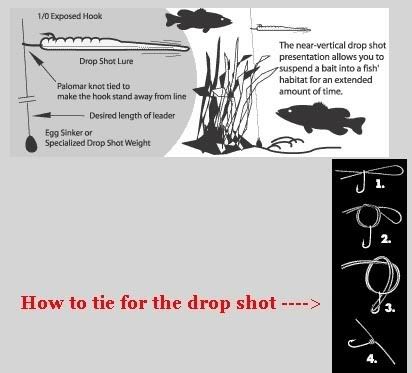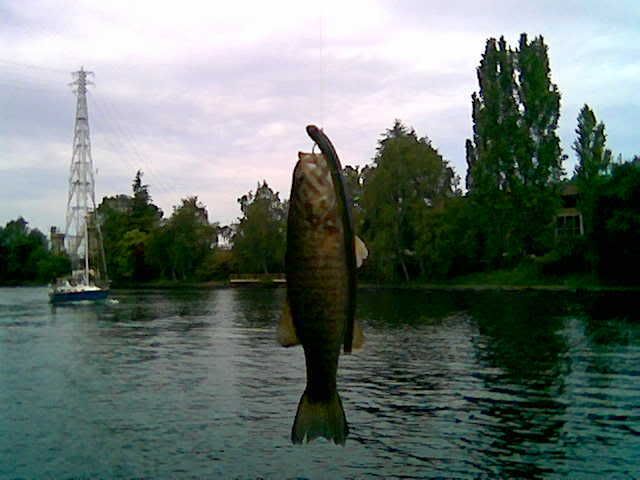I agree with WCCT 100% with regard to weight selection and hooks. Also, I try to use the lightest line I can get away with based on the cover I am facing. I have noted a more strikes the thinner diameter and less visible the line.
With regard to your case, it was probably more a result of the fish not being near your offering or your presentation.
Below is a small sharing of my personal experience with learning the drop shot. I can definitely relate with what you're going through I put in a lot of time and paid the dues before it started to click, to the point I was about to sign off on thinking the drop shot was an over-hyped junk tactic. Thank goodness I didn't quit in the end! Whew!
Islandbass’ Take on the Drop Shot
I am no expert by any stretch of the imagination, but I have grown fond of the Drop Shot technique in my short, six-season fishing journey. I found this technique to be a very productive method to catch fish in a variety of states. In my first outing for fishing for smallmouth bass ever, I hooked and caught 3 smallies on three consecutive casts. It is the only method that has done this for me to date, and from the shore to boot. At the very least, I can share with you what I have learned through trial, error, and experience (which isn't much).
Basic Drop Shot Diagram
Here is a generic set up.
 Rod and Reel Type
Rod and Reel Type
You don't need a Drop Shot specific rod. A medium-light to medium-powered rod with a moderate to extra-fast action, and a length ranging from 6'3" on up to just over 7' should work for you for now, unless you plan to fish heavier cover. If you find drop shotting to your liking, you can then opt to go with a Drop Shot specific rod of your choice. As a rule of thumb, a longer rod will enable you to have more line control and leverage; two big pluses in drop shotting.
I prefer spinning reels (a size 20 or 2500 reel is an excellent choice) because they require less work to give the bait a better (IMHO) descent than a baitcast reel. Sorry baitcast reel users, but the way a spinning drops the bait (for ¼ oz weights and less) smokes a baitcast reel any and every day for drop shotting. To those who use baitcast reels exclusively, please note I said for drop shotting in its basic, finesse form (lighter lines, weights, and smaller baits). There will not be a need to strip line off just to make the bait fall.
With that said, casting reels can also be used. I just prefer a spinning reel. You may use whatever reel you want. Even a Barbie pole can get it done for drop shotting! However, I would not hesitate to use heavier line, weights, larger baits and a baitcast reel if I were to drop shot heavy cover. Something I call Alpha Shotting!
Drop Shot Weight and Type
A 3/16 - 1/4 oz weight is a good starting weight. Going any lighter might make it harder for you to read what is going on until you get experience. As for the shape, I like to use either the teardrop (WCCT weights rock!) or cylindrical shape and prefer the former as my first choice. I have not experimented with other shapes. Windier conditions and stronger currents might make you want to choose a heavier weight, but let’s not worry about that for now.
Line
Because you are drop shotting, lighter line is preferred if the cover you are fishing allows it. Go up in # strength if the cover dictates this. I like and use 6# fluorocarbon, particularly Seaguar's Invizx. This line kicks fanny. No doubt about it. The plus in going with fluorocarbon in a higher # test if needed is despite having a slightly thicker line diameter; the angler retains the benefit of fluorocarbon’s trait of near invisibility as advertisers so claim. Whichever line you choose, I think the fluorocarbon line of your choice will be fine.
I know that some also prefer to use braid. I know the benefits of braid and am not against it and maybe someday I’ll use it with a fluorocarbon leader. Given the amount of sensitivity my rod and line provide me, I just don’t have a need to take it up a notch to braid for the typical depths I fish, which is usually no more than 20’. If you plan to fish greater depths, braid may very well be the ticket. The enhanced sensitivity braid provides can be a plus.
Baits
Keep an open mind here. Many baits of a variety of shapes can be used. The general rule of thumb is a tendency to use smaller baits since we are "finesse" fishing (translates to downsizing in general). The typical length of a drop shot bait usually ranges from 3" - 4.5" but this is NOT set in stone. Roboworms, Senkos, Sniper Snubs and Bolts (the latter two are locally made baits), Reaction Innovations Flirts, and heck, even Baby Brush Hogs and Tubes can be used. Think out of the box. I have used longer worms too. This season, the 4.5” Roboworm (in Aaron’s Magic) and Sniper Snubs in Watermelon and Dark Brown have been so effective that to date I have not seen a need to try something else or other colors. It might be different for bass in other waters. If you wish to know, so far the most effective baits for me have been, the snubs and roboworms.
Here is a picture of a smallie I caught on a longer Roboworm hoping for a bigger smallie. The darn Roboworm is nearly as long as the smallie!
 Hooks/Knot
Hooks/Knot
I prefer to use size 1 or 2 (mostly size 2) Owner Mosquito or Gamakatsu Split Shot/Drop Shot hooks. If I am fishing a grassy area in which grass can catch the exposed hook, I opt for the Owner Down Shot hook, which is in essence a mini version of an EWG (extra wide gap) worm hook. Naturally, if you plan to drop shot much larger baits, you might need to go up in hook size.
I attach the hook to the line with a Palomar knot and after it is tied, I insert the extra line (tag end) through the hook's eye before attaching the weight.
Tag End Length (Distance from the hook to the weight)
The best way to figure this out is to experiment. I have had success with the tag end being as short as 4-6" to nearly but not quite 24”. Because drop shotting is not limited to a purely vertical presentation, a longer leader is a good idea if you wish to work it somewhat like a Texas or Carolina rig. The longer leader length or tag end (which I define here as the distance between the weight and your hook, perhaps 18" as a ballpark figure) will enable you to keep the bait off the ground with the shallow angle that will result from a long cast. For a more vertical presentation, a shorter distance from the hook to the bait can work. Another influencing factor is the depth at which the fish are staying. You might need to adjust your tag end accordingly.
Imparting Life to the Lure
Despite the initial perception of working this lure, it is not all about jiggling and wiggling the bait to death. An angler can indeed work the bait this way, but I can tell you from personal experience, that wiggling and jiggling the bait to death (continuously) has accounted for the fewest number of catches. By no means am I saying to not wiggle and jiggle it to death. That is only one method.
So what should one do in addition to the wiggling/jiggling tactic?
Keep the weight on the bottom for the most part and leave enough slack to let the bait sink on its own weight. Then, when you think the bait is near the bottom lift/twitch the rod just enough to move the bait a little (without moving or minimizing the movement of the weight on the bottom) and repeat. In effect, what you are doing is working a semi-slack line and this is what is imparting action to the bait. No hits? Repeat if you wish, or add a little dead sticking to the mix or, drag your bait to the next spot. All are good choices. The dragging of the weight from one spot

